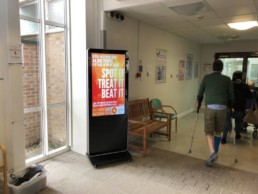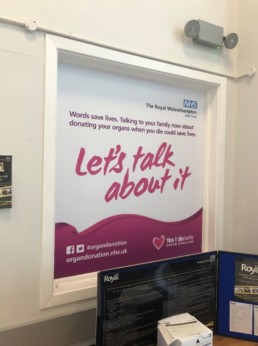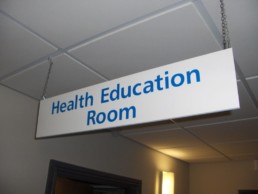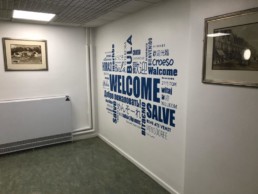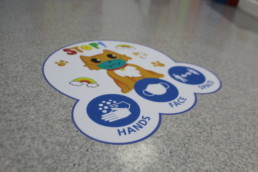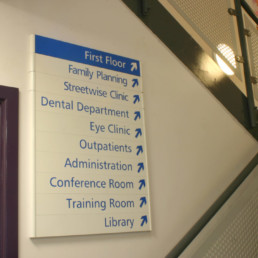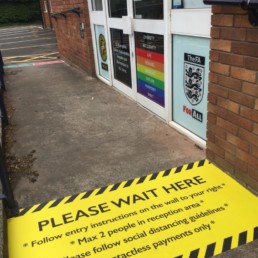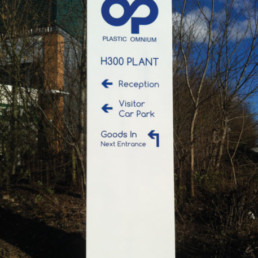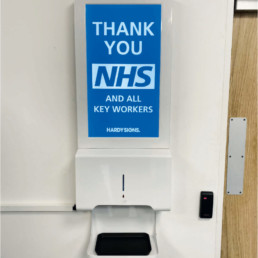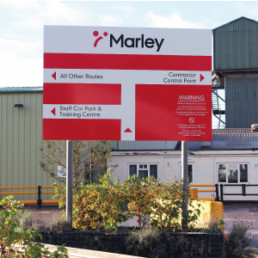How many times have you got lost in a hospital? How many times have you parked in the wrong area or asked for directions? According to a 2018 report from Deloitte, 87% of patients had asked for guidance when visiting a medical facility. The report states that during 2016-2017, 8 million appointments were missed, leading to losses of several hundred million pounds.
Hospitals and doctors’ surgeries across the United Kingdom are used daily. Most of these places are large buildings, and therefore wayfinding systems are needed to help visitors, patients, employees, and contractors to find their way inside and outside the premises.
From digital touchscreen displays to vinyl graphics, in this blog, we will be looking at how these solutions are vital and which ones are best for their location.
According to an NHS UK document, ‘’Wayfinding’’ covers all to do with how people find their way in different environments. In the context of the NHS, it is not just a term referred to as signage. For example, the Disability Discrimination Act, which came into force in 2004, had significant implications for healthcare facilities. Their sites must allow access to all areas and remove all barriers for disabled people. They are also required to provide accessible information aids such as large-print written directions, among other elements, to enable people who are deaf to lip-read.
> There are three main factors that affect wayfinding.
1 – People factors
The ability and knowledge of the person making a journey to find their way. Main people factors are emotional state, attitude, choice of mode of transport, ability to understand the language used on signs, mobility, ability to read and hear.
2 – Environmental factors
Environment impacts the journey to the medical facility, which affects how easy people find it to make appropriate decisions. The main environmental factors are the complexity of the site, routes and interiors of the buildings, recognisability of the venue, identifiability of the site entrance from all directions, visibility of the entrance and prominent landmarks for people to notice.
3 – Information factors
People look out for several touchpoints to help them find their way. The clarity, accuracy and positioning of wayfinding signs will vary from hospital to hospital and even from department to department. There are four types of information points: Pre-visit information, En-route information, On-site information and Locational information.
Some signs that would enable you to achieve an efficient wayfinding directorate:
Digital Signage
This is one of the most popular solutions in hospitals and surgeries as the different options can help in various areas. For example, you can use digital screens in the waiting room to communicate important information such as patients’ names, doctor’s room numbers, names, etc.
“According to ScreenCloud, 75% of patients viewing a digital sign in a hospital could recall at least one message displayed. Overall, this means that visitors and patients will be exposed to initiatives in the healthcare facility. Therefore, it has a high potential for advertising opportunities and may help defer time-consuming questions from nursing staff.”
Window Graphics
This solution enables you to add your branding, opening and closing hours and contact details to your windows. They are helpful to passers-by both when you are open and closed. Local residents could walk by, take a picture of your details or write them down to contact when you are open.
A range of frosted and solar films are available to reduce glare or to offer increased privacy. You can use this solution for small panels or wrap the whole window; that’s entirely up to you. These can be as colourful or decorative as you want them to be. Our large format printing capabilities enable us to produce high-resolution graphics.
Physical Solutions
Physical Solutions are vital in helping people locate their destination or route. They make over 90% of the wayfinding system. These solutions include totems, hanging signs, post and panel, wall graphics and more. We will look at these solutions separately below.
Totems and Post and Panel Signs
They can usually be found at the front of a healthcare facility, around the main entrance or at a strategical point outside the premises to direct the drivers. They typically integrate a mix between branding and wayfinding and are one of the most popular signs that you would expect to find in every major healthcare facility.
Both solutions are made of durable sign systems and can be customised with digital print and bespoke shapes and are built to resist all types of weather conditions.
Based on NHS guidelines, we consider the environment and background colour, because the environment in which the sign is placed affects noticeability and legibility. The background colour used on signs should contrast with the environment to ensure signage is prominent. When the contrast isn’t sufficient, we place a contrasting border around the signs.
Suspended Ceiling Signs
Can be found everywhere in healthcare facilities and require a larger typeface than signs positioned at eye level. NHS guidelines recommend that the height for a suspended sign should be at just over 2 metres. Hanging signs are a crucial part of the wayfinding directorate and ensuring that they are designed and positioned in the right way is essential.
Wall Graphics
Whether you use giant arrows to point to a specific direction or show what floor people are on, wall graphics provide a great way of using wayfinding signage. Wall graphics are interchangeable; they can be easily removed or rebranded if plans change in the future.
They are designed for many different purposes. For example, for a children’s ward, using bright colours and cartoon characters that advise on where to go is likely to put children at ease.
Floor Graphics
There are designed to be walked on and are placed in high footfall areas. They were one of the most searched terms on the internet when the pandemic Covid-19 started as they acted as wayfinding, queue management and health and safety solutions.
We recently donated floor graphics to the University Hospitals of Derby and Burton. They showed the message ‘Hands, Face, Space’ to remind everyone to follow the safety guidelines in place.
Using our award-winning creative and installation teams and environmentally friendly printers, we can manage your project from the beginning to the end. Anti-slip laminate could also be used for external floor graphics.
You can read more here:
Conclusion
Our signs can be manufactured to be fully interchangeable to allow maximum flexibility and can be located on the ground, on a wall or suspended above to suit the location and aim. We also offer illuminated wayfinding options to maximise prominence, visibility, and identifiability.
Healthcare facilities are critical in society and strict NHS guidelines require continuous optimisation of the signage provision to guarantee accessibility and up to date information. Our team have been working with the NHS for over 20 years and we are up to date with the latest brand guidelines.
We are here to help. Get in touch to find out more.
Like what you see here?
Get in touch with us to see how we can help your business or brand.
Call us on 01283 569 102
